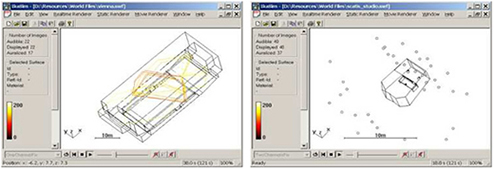IKA-SIM
The Institute of Communication Acoustics has a long history in research and development of AVE systems (e.g. Lehnert and Blauert 1989). In (Blauert et al. 2000, and Djelani et al. 2000) the DSP-based real-time AVE system SCATIS is presented and evaluated. The present PC-based implementation is the interactive AVE system IKA-SIM, in which the position of the listener and various sound sources can be controlled in real-time (Silzle et. al 2004). Subject of current work is the extension of IKA-SIM with network functionality and by this the possibility to use it as a backend for Web-based applications. IKA-SIM is also used in the EU project HEARCOM in conjunction with screening tests for hearing impaired listeners in adverse conditions.
In recent research activities we investigated strategies to find an optimal set of parameters in the physical and the perceptual domain which results in a good compromise between listening experience and implementation effort (Silzle 2005). One part of this optimisation process is to find or generate the best non-individual head-related transfer functions (HRTF), which are one important part for the headphone reproduction of an AVE (Silzle 2002 and 2003). Another research activity is a 3D loudspeaker reproduction, using a new method for elevation panning with 14 channels (Gretzki and Silzle 2004).
A lot of applications use the AVE approach, like e.g. man-machine communication, teleconferencing, virtual acoustics, hi-fi, computer games, television, cinema and many more. The complexity of the technical implementation differ significantly between different applications and implementations. Most of today's Virtual Reality applications mainly focus on visual feedback. However, including auditory feedback can significantly improve the perception of being immersed in a Virtual Environment.
Listening examples:
Four
different sound sources in standard reproduction (localisation
inside the head)
Four different
sound sources treated with IKA-SIM (natural localisation outside
the head)

Fig. 1: Mirror sources in a sound
studio environment and sound traces in the concert hall
Musikvereinssaal in Vienna simulated with the interactive
real-time software "IKA-SIM"
References
Blauert J (1997). Spatial Hearing, The
Psychophysics of Human Sound Localisation (Second edition),
MIT Press, (Original German version 1974)
Blauert J ed. (2005). Communication
Acoustics, Springer
Blauert J, Lehnert H, Sahrhage
J, Strauss H (2000). An Interactive Virtual-Environment Generator
for Psychoacoustic Research. I: Architecture and Implementation,
Acustica – acta acustica, Vol 86, pp. 94-102
Djelani T, Pörschmann
C, Sahrhage J and Blauert J (2000). An Interactive Virtual-Environment
Generator for Psychoacoustic Research II: Collection of Head-Related
Impulse Responses and Evaluation of Auditory Localization,
Acustica – acta acustica Vol.86, pp. 1046-1053
Gretzki R and Silzle A (2004).
A New Method for Elevation Panning Reducing the Size of the
Resulting Auditory Events, Proc. 7. Congrès Français
d'Acoustique / 30. Dtsch. Jahrestg. f. Akust. (CFA/DAGA'04),
F-Strassburg
Lehnert H, and Blauert J (1989).
A concept for binaural room simulation. In: Proc. IEEE ASSP
Worksh. Application of Signal Processing to Audio and Acoustics,
New Paltz NY
Silzle A (2002). Selection
and Tuning of HRTFs, 112th AES Convention, Munich, Germany,
#5595
Silzle A (2003). Quality of
Head-Related Transfer Functions - Some Practical Remarks,
First ISCA Tutorial & Research Workshop on Auditory Quality
of Systems, Akademie Mont-Cenis, Germany
Silzle A, Novo P, Strauss
H (2004). IKA-SIM: A System to Generate Auditory Virtual Environments,
116th AES Convention, Berlin, Germany, #6016
Silzle A (2005). Optimierungsmethode
für Systeme zur Generierung von auditiven virtuellen
Umgebungen (optimisation method for systems to generate auditory
virtual environments), 31. Dtsch. Jahrestg. f. Akust. (DAGA
,05), München, Germany

